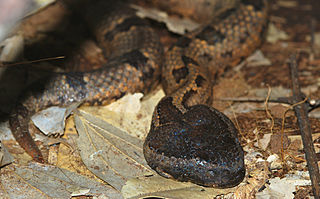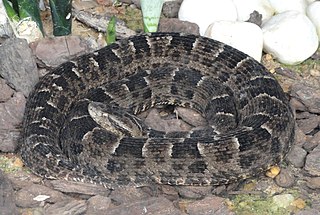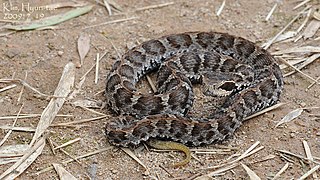
Gloydius himalayanus also known as the Himalayan pit viper or the Himalayan viper is a venomous pitviper species found along the southern slopes of the Himalayas in Pakistan, India and Nepal. No subspecies are currently recognized. Himalayan pit vipers have been found up to 4900m above sea level, which makes it the highest living snake ever found.

Ovophis monticola, commonly known as the Chinese mountain pit viper, is a venomous pitviper species found in Asia. Currently, two subspecies are recognized, including the nominate subspecies described here. Recent taxonomic work suggests that most of these should be considered as separate species. IUCN has already evaluated O. m. makazayazaya as Ovophis makazayazaya.

Protobothrops mucrosquamatus is a venomous pit viper species endemic to Asia. Common names include: brown-spotted pit viper, Taiwanese habu and pointed-scaled pit viper. No subspecies are currently recognized. The species was first described by Theodore Cantor in 1839.

Eryx conicus, also known as Russell's sand boa, the Common sand boa or the rough-tailed sand boa, is a species of non-venomous snake in the subfamily Erycinae of the family Boidae. The species is native to Southern Asia. No subspecies are recognised.

Atheris desaixi, commonly known as the Mount Kenya bush viper, Ashe's bush viper, or Desaix's bush viper, is a venomous species of viper endemic to Kenya, where only two isolated populations are known. It is known for its striking black and yellow coloration. No subspecies are currently recognized.

Echis carinatus sochureki is a venomous viper subspecies found in India, Pakistan, Afghanistan, Iran, and parts of the Arabian Peninsula.

Wagner's viper, known as the ocellate mountain viper, ocellated mountain viper, and Wagner's viper, is a species of venomous snake in the subfamily Viperinae of the family Viperidae. The species is native to eastern Turkey and northwestern Iran. There are no subspecies that are recognized as being valid.

Gloydius saxatilis is a venomous pitviper species endemic to Russia, China and the Korean Peninsula. No subspecies are currently recognized.

Gloydius halys is a venomous pitviper species found within a wide range that stretches across Asia, from Russia, east of the Urals, eastwards through China. Five subspecies are currently recognized, including the nominotypical form described here.

Bothrops neuwiedi is a highly venomous pit viper species endemic to South America. This relatively small snake has a wide range and is a major source of snakebite in Argentina. It was named after German naturalist Prince Maximilian of Wied-Neuwied (1782-1867), who made important collections in Brazil (1815-1817). Seven subspecies are currently recognized, including the nominate subspecies described here.

Ovophis okinavensis, commonly known as the hime habu (ヒメハブ), Ryukyu Island pit viper, and the Okinawan pitviper, is a venomous pitviper species found in the Ryukyu Islands of Japan. No subspecies are currently recognized.

Hypnale nepa, the Sri Lankan hump-nosed viper, is a venomous pitviper species endemic to Sri Lanka where it is known as මූකලන් තෙලිස්සා in Sinhala. Earlier thought that Hypnale walli and Hypnale nepa were two distinct species, but it is now accepted that it is the same species and Hypnale walli is a synonym name. Relatively small, they are distinguished by a strongly upturned snout. No subspecies are currently recognized.
Hypnale walli, or Wall's hump-nosed viper, is a venomous pitviper species endemic to Sri Lanka. The smallest member of its genus, it is distinguished by having a strongly upturned nose and lower scale counts. No subspecies are currently recognized.

Gloydius intermedius, or Central Asian pit viper, is a venomous species of pitviper endemic to northern Asia. Three subspecies are currently recognized, including the nominate subspecies described here.
Gloydius monticola is a venomous pitviper species endemic to southern China. A small and darkly colored snake with no visible color pattern, it is found high in the mountains of northern Yunnan province. No subspecies are currently recognized.
Gloydius shedaoensis is a venomous pitviper species found only on Shedao Island in China. Although very small, this island is home to an extraordinarily large population of these snakes. No subspecies are currently recognized.
Gloydius strauchi is a species of venomous pit viper in the subfamily Crotalinae of the family Viperidae. The species is native to western China. It is a small snake with a pattern of four longitudinal stripes, although some older specimens may be a uniform black. G. strauchi may be distinguished from G. monticola by its higher midbody dorsal scale count. This species jointly holds the altitude record for pitvipers together with Crotalus triseriatus of Mexico, both being found even above the tree line at over 4,000 m (13,000 ft). No subspecies were recognized as being valid, until a recent publication re-evaluated the taxonomic statuses of populations of G. strauchi and described the eastern Tibetan populations as a new species.

Gloydius brevicauda is a venomous pitviper species endemic to China and the Korean Peninsula.
Bothrops pulcher is a venomous pitviper species found in South America. The specific name is Latin, meaning "beautiful", in reference to the color pattern. No subspecies are currently recognized.
Bothrocophias andianus is a venomous pit viper species endemic to the Andes in South America. No subspecies are currently recognized.















